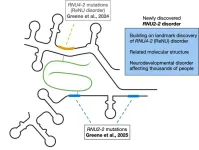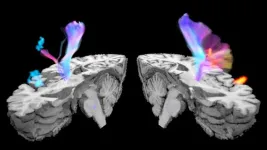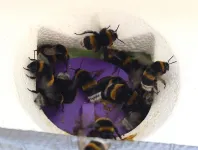(Press-News.org) The first few days of a human embryo’s development, known as pre-implantation, are important. It’s when the first cells are formed, and these decide if the embryo can survive, how it will implant in the womb and how the tissues of the fetus will develop.
Today there are still logistical, ethical and legal limitations to using human embryos for research purposes, so scientists use alternative models including stem cell-based and animal models.
In a new study published in Nature Cell Biology, Sophie Petropoulos, a researcher at both Université de Montréal’s affiliated hospital research centre, the CRCHUM, and the Karolinska Institutet, in Sweden, shows that guinea pigs can serve as a reliable and robust small animal model to enhance our understanding of two key areas of research: comparative biology and human embryogenesis.
The guinea pig has long been used for studies in developmental biology and is very similar to humans in terms of general physiology. It is also the only small animal that, in females, goes through a full estrous cycle as women do, undergoes a similar implantation process and develops similar placentas.
“Despite these noted similarities, preimplantation development had not been studied,” said Petropoulos, an associate professor at UdeM and holder of a Canada Research Chair in Functional Genomics of Reproduction and Development. “Our lab is focused on understanding infertility and early human development, so we wanted to identify a model that we could use to answer our questions.”
A complete atlas of genes
“In our study, we used a technique known as single-cell RNA sequencing to produce a complete atlas of the genes involved in the guinea pig pre-implantation development, and examined their timing and expression. We also inhibited and activated signalling pathways to see how these genes could affect embryo development” she said. “When we compared the development of the guinea pig embryo to our previous work, we were very surprised by its striking resemblance to early human embryogenesis.”
That discovery opens new possibilities for understanding women’s infertility and for developing therapeutics to help ensure a healthy pregnancy, said Petropoulos, who was aided in her study by its two first authors: Jesica Romina Canizo, a research associate in Petropoulos’ lab at the CRCHUM, and Cheng Zhao, a research specialist in her lab at the Karolinska Institutet.
“The guinea pig model can help scientists understand how early exposure to drugs or environmental disruptions affect the health outcomes for babies in the long term, or why some women have recurring implantation failure,” Petropoulos said.
She and her team have now started to study post-implantation embryo development and gastrulation, during which all the organs and tissues of the human body are formed. With 80 per cent of pregnancy failures occurring in the first trimester, scientists are keen to understand this period of human development, known as the “black box”.
In the long term, the guinea pig preimplantation embryo model might provide extremely useful information about the best conditions for the development of healthy embryos and fetuses, Petropoulos and her team believe. This could help to improve fertility treatments and assist reproductive technologies.
About this study
“The guinea pig serves as an alternative model to study human preimplantation development,” by Jesica Romina Canizo and Cheng Zhao under the supervision of Sophie Petropoulos, was published online April 4, 2025, in Nature Cell Biology. Funding was provided by the CRCHUM, the Research Center in Reproduction and Fertility, the Swedish Research Council and the Swedish Society for Medical Research. The research utilized the CRCHUM’s cellular imaging core facility and the animal facility.
END
Guinea pigs: A promising animal model to study the human embryo
2025-04-10
ELSE PRESS RELEASES FROM THIS DATE:
The rise of "gut feelings" in US political rhetoric
2025-04-10
Discussion of "alternative facts" has gained sad notoriety in US politics. Yet the question has been around much longer: How do people conduct political debates – is the focus more on facts or personal opinions? A team of international researchers led by the Cluster of Excellence "The Politics of Inequality" looked into the matter. The researchers examined political rhetoric in eight million speeches by members of the US Congress between 1879 and 2022 to see if the focus of their language was more on data and facts or personal convictions and subjective interpretations.
The team noticed a significant decline in the use of evidence-based political ...
How mothers adapt to the metabolic demands of nursing
2025-04-10
Nursing poses major metabolic demands on mothers, to which they respond by eating more and saving energy to sustain milk production. There are significant hormonal changes during lactation, but how they lead to metabolic adaptations in nursing mothers remained unclear. In this study, which appeared in Nature Metabolism, leading researchers at Baylor College of Medicine and Pennington Biomedical Research Center uncovered a mechanism that connects prolactin, estrogen, the brain and metabolic adaptations during lactation.
“We worked with animal models to investigate ...
Caspian Sea decline threatens endangered seals, coastal communities and industry
2025-04-10
UNDER EMBARGO UNTIL THURSDAY 10 APRIL, 10AM LONDON TIME, 5AM EASTERN TIME.
Urgent action is needed to protect endangered species, human health and industry from the impacts of the Caspian Sea shrinking, research led by the University of Leeds has found.
Water levels in the Caspian Sea – the world’s largest landlocked water body – are getting lower, as hotter temperatures cause more water to evaporate than is flowing in. Even if global warming is limited to below 2°C, ...
Landmark study identifies new genetic cause of neurodevelopmental disorders, bringing long-awaited answers to families
2025-04-10
New York, NY [April 10, 2025]—A seminal study from researchers at the Icahn School of Medicine at Mount Sinai and their collaborators in the United Kingdom, Belgium, Spain, the Netherlands, and Iceland has uncovered a new genetic cause of neurodevelopmental disorders (NDDs). The discovery offers both closure and hope to potentially thousands of families worldwide who have long been searching for answers.
The study, published in the April 10 online issue of Nature Genetics [DOI: 10.1038/s41588-025-02159-5], reveals that mutations in a small, previously overlooked non-coding gene called RNU2-2 are responsible for relatively common NDD. Non-coding genes ...
Scientists create “metal detector” to hunt down tumors
2025-04-10
Researchers have created a “metal detector” algorithm called PRRDetect to hunt down vulnerable tumours, in a development that could one day revolutionise the treatment of cancer.
In a paper published today (Thursday 10th April) in Nature Genetics, scientists funded by Cancer Research UK and the National Institute for Health and Care Research (NIHR) analysed the full DNA sequence of 4,775 tumours from seven types of cancer. Based at the University of Cambridge and NIHR Cambridge Biomedical Research Centre, they used that data from Genomics England’s 100,000 Genomes ...
New USC study identifies key brain networks behind post-stroke urinary incontinence
2025-04-10
A new USC-led study using functional magnetic resonance imaging (fMRI) reveals the neural mechanisms that contribute to urinary incontinence, a common condition affecting stroke survivors that has a significant impact on their quality of life.
The research, just published in Stroke, was conducted by a multidisciplinary team of urologists, neurosurgeons, and imaging experts from the Keck School of Medicine of USC, Keck Medicine of USC, the Rancho Los Amigos National Rehabilitation Center, and the Shirley Ryan Ability Lab. The team discovered significant differences in brain activity during voluntary versus involuntary bladder contractions, presenting potential pathways for targeted therapies.
Urinary ...
Hidden potential in multiple disabilities
2025-04-10
Using eye-tracking — a technique for recording and analysing eye movements — a team from the University of Geneva (UNIGE) has shown that individuals with multiple disabilities can improve their social and emotional skills. Although these patients are often considered ‘‘untestable’’, nine young people have undergone personalised training over a period of one year, with promising results in terms of their ability to socialise. This work opens the way to new methods of assessment and support. It is published in Acta Psychologica.
Multiple disabilities involve a combination of severe intellectual and motor impairments, resulting in profound dependence. ...
How to protect bumblebee colonies safe from killer moths? Keep honeybee hives away from them
2025-04-10
Since the pandemic, we are very aware of the power of social distancing to protect against infectious disease. But can social distancing be effective if the infectious agent isn’t a virus or bacterium, but an insect powered by a brain and wings, and with the instinct to seek out new hosts?
Now, a study published to Frontiers in Bee Science has shown that physical distance does play a leading role in protecting bumblebees against a flying insect parasite, the bumblebee wax moth Aphomia sociella. The source of the potentially lethal infection was another species, namely nearby hives of domestic honeybees.
“Here we show that infestation with bumblebee wax moths is much greater ...
Rolling particles make suspensions more fluid
2025-04-10
Lacquers, paint, concrete—and even ketchup or orange juice: Suspensions are widespread in industry and everyday life. By a suspension, materials scientists mean a liquid in which tiny, insoluble solid particles are evenly distributed. If the concentration of particles in such a mixture is very high, phenomena can be observed that contradict our everyday understanding of a liquid. For example, these so-called non-Newtonian fluids suddenly become more viscous when a strong force acts upon them. For a brief moment, the liquid behaves like a solid.
This sudden thickening is caused by the particles present ...
Research fine tunes tools used to search for genetic causes of asthma
2025-04-10
Genome wide association studies (GWAS) have identified hundreds of genome regions containing thousands of genetic variants associated with asthma, but it’s still not clear which variants have an actual causal link to the disease. This “variant-to-function” gap is one of the biggest challenges to the usefulness of these genomic studies and has motivated researchers to develop new tools to make sense of GWAS results.
A new study by researchers from the University of Chicago combines genetic data and improved computational tools to look more closely ...




